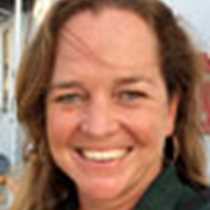Santa Cruz Island
After several days spent in entirely pristine, uninhabited National Park territory we awoke in the bustling Academy Bay, home to the largest human settlement in the Galápagos Archipelago. Santa Cruz is the second largest of the Galápagos Islands and is a middle-aged island located at the heart of the group. It is tall enough to intercept the low cloud cover, resulting from the inversion layer caused by cool ocean temperatures, which lies over the area during much of the year; as such, the hilly highlands of this old volcano mostly lie smothered under a blanket of thick moisture-filled cloud. Although straddling the equator, the cool waters that bathe the stark coastlines here create very dry conditions in most of the archipelago, with differential precipitation depending on altitude and the direction the flanks of the volcanos are facing.
We disembarked on the main town dock in the busy port town of Puerto Ayora, our first destination the famed Charles Darwin Research Station. Here we learned about the invaluable work this non-governmental organization has been undertaking since 1964, and its vitally important role as scientific advisor to the Ecuadorian governmental branch of Galápagos conservation, the Galápagos National Park Service. Together, the two organizations have been working tirelessly to restore the islands to their former pristine ecological state, and have brought many critically endangered species back from the very brink of extinction. Most notable among these are the giant tortoises, and it was hugely enjoyable to learn about the captive breeding program that has been so successful in repopulating several islands with their native reptiles, and being able to compare the morphological differences occurring among the tortoises of low arid islands and those of larger highlands with green, humid highlands. It was particularly poignant to later travel to the highlands of Santa Cruz, which is home to a good-sized population of tortoises (many of whom started life in the Fausto Llerena breeding centre), and see these endemic reptiles in the wild. Now the dry season has started and the lower flanks of Santa Cruz are returning to their usual arid conditions, the tortoise breeding season ends and these magnificent relics of a past era have begun to migrate up to the green pastures found at elevation.
But the efforts of the GNPS and CDF are not restricted to the fauna of the islands, but also to the equally unique and endangered flora. The upper reaches of Santa Cruz are home to some of the last significant stands of endemic Scalesia pedunculata cloud forests, all but 5% of which have been replaced during early human colonisation by pastures and agriculture. Where the clouds condense over the summit of the volcano, there grow dense elfin forests of these small elegant tree (giant members of the sunflower and daisy family), their twisted limbs covered in epiphytic plants such as mosses, orchids, lichens and bromeliads, all taking advantage of the tree branches to capture the moisture saturating the air. These magical woods are mostly being replaced by aggressively invasive species introduced by early settlers, such as guayaba and quinine tree, and intensive eradication and reforestation projects are important components of the ecological restoration of the Galápagos. It was fascinating, after days in the arid lowlands of the Galápagos, to experience such an entirely different ecosystem; we returned to the ship that evening feeling that whole new sides of these enchanted islands had been revealed to us during the day’s explorations.




